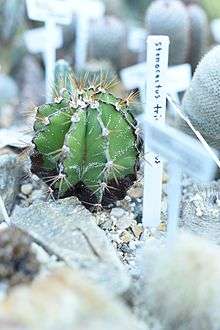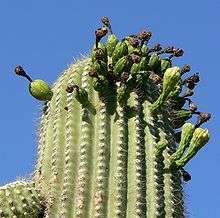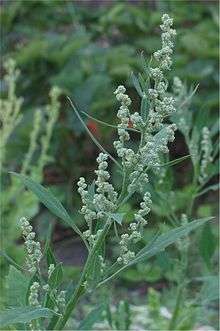Caryophyllales
| Caryophyllales | |
|---|---|
| | |
| Dianthus caryophyllus | |
| Scientific classification | |
| Kingdom: | Plantae |
| Clade: | Angiosperms |
| Clade: | Eudicots |
| Clade: | Superasterids |
| Order: | Caryophyllales Juss. ex Bercht. & J.Presl[1] |
| Suborders | |
|
Caryophyllineae | |
| Synonyms | |
Caryophyllales is an order of flowering plants that includes the cacti, carnations, amaranths, ice plants, beets, and many carnivorous plants. Many members are succulent, having fleshy stems or leaves.
Description
The members of Caryophyllales include about 6% of eudicot species.[2] This order is part of the core eudicots.[3] Currently, the Caryophyllales contains 33 families, 692 genera and 11,155 species.[4] The monophyly of the Caryophyllales has been supported by DNA sequences, cytochrome c sequence data and heritable characters such as anther wall development and vessel-elements with simple perforations.[5]
Circumscription
As with all taxa, the circumscription of Caryophyllales has changed within various classification systems. All systems recognize a core of families with centrospermous ovules and seeds. More recent treatments have expanded the Caryophyllales to include many carnivorous plants.
Although the monophyly of the order has been strongly supported, their placement is still uncertain. Systematists are undecided on whether Caryophyllales should be placed within the rosid complex or sister to the asterid clade.[5] The possible connection between sympetalous angiosperms and Caryophyllales was presaged by Bessey, Hutchinson, and others; as Lawrence relates: "The evidence is reasonably conclusive that the Primulaceae and the Caryophyllaceae have fundamentally the same type of gynecia, and as concluded by Douglas (1936)(and essentially Dickson, 1936) '...the vascular pattern and the presence of locules at the base of the ovary point to the fact that the present much reduced flower of the Primulaceae has descended from an ancestor which was characterized by a plurilocular ovary and axial placentation. This primitive flower might well be found in centrospermal stock as Wernham, Bessy, and Hutchinson have suggested.' "[6]
Caryophyllales is separated into two suborders: Caryophyllineae and Polygonineae.[5] These two suborders were formerly (and sometimes still are) recognized as two orders, Polygonales and Caryophyllales.[5]
APG III
As circumscribed by the APG III system (2009), this order includes the same families as the APG II system (see below) plus the new families, Limeaceae, Lophiocarpaceae, Montiaceae, Talinaceae, and Anacampserotaceae.[1] Kewaceae, Limeaceae, Macarthuriaceae, Microteaceae, and Petiveriaceae were added in APG IV. [7]
- family Achatocarpaceae
- family Aizoaceae
- family Amaranthaceae
- family Anacampserotaceae
- family Ancistrocladaceae
- family Asteropeiaceae
- family Barbeuiaceae
- family Basellaceae
- family Cactaceae
- family Caryophyllaceae
- family Didiereaceae
- family Dioncophyllaceae
- family Droseraceae
- family Drosophyllaceae
- family Frankeniaceae
- family Gisekiaceae
- family Halophytaceae
- family Kewaceae
- family Limeaceae
- family Lophiocarpaceae
- family Macarthuriaceae
- family Microteaceae
- family Molluginaceae
- family Montiaceae
- family Nepenthaceae
- family Nyctaginaceae
- family Petiveriaceae
- family Physenaceae
- family Phytolaccaceae
- family Plumbaginaceae
- family Polygonaceae
- family Portulacaceae
- family Rhabdodendraceae
- family Sarcobataceae
- family Simmondsiaceae
- family Stegnospermataceae
- family Talinaceae
- family Tamaricaceae

APG II
As circumscribed by the APG II system (2003), this order includes well-known plants like cacti, carnations, spinach, beet, rhubarb, sundews, venus fly traps, and bougainvillea. Recent molecular and biochemical evidence has resolved additional well-supported clades within the Caryophyllales.
- order Caryophyllales
- family Achatocarpaceae
- family Aizoaceae
- family Amaranthaceae
_W_IMG_1562.jpg) Pupalia lappacea Forest Burr from family Amaranthaceae
Pupalia lappacea Forest Burr from family Amaranthaceae - family Anacampserotaceae (added in APG III)[1]
- family Ancistrocladaceae
- family Asteropeiaceae
- family Barbeuiaceae
- family Basellaceae
- family Cactaceae
- family Caryophyllaceae
- family Didiereaceae
- family Dioncophyllaceae
- family Droseraceae
- family Drosophyllaceae
- family Frankeniaceae
- family Gisekiaceae
- family Halophytaceae
- family Limeaceae (added in APG III)[1]
- family Lophiocarpaceae (added in APG III)[1]
- family Molluginaceae
_W2_IMG_0462.jpg) Glinus oppositifolius from family Molluginaceae
Glinus oppositifolius from family Molluginaceae - family Montiaceae (added in APG III)[1]
- family Nepenthaceae
- family Nyctaginaceae
- family Physenaceae
- family Phytolaccaceae
- family Plumbaginaceae
- family Polygonaceae
- family Portulacaceae
- family Rhabdodendraceae
- family Sarcobataceae
- family Simmondsiaceae
- family Stegnospermataceae
- family Talinaceae (added in APG III)[1]
- family Tamaricaceae
APG

This represents a slight change from the APG system, of 1998
- order Caryophyllales
- family Achatocarpaceae
- family Aizoaceae
- family Amaranthaceae
- family Ancistrocladaceae
- family Asteropeiaceae
- family Basellaceae
- family Cactaceae
- family Caryophyllaceae
- family Didiereaceae
- family Dioncophyllaceae
- family Droseraceae
- family Drosophyllaceae
- family Frankeniaceae
- family Molluginaceae
- family Nepenthaceae
- family Nyctaginaceae
- family Physenaceae
- family Phytolaccaceae
- family Plumbaginaceae
- family Polygonaceae
- family Portulacaceae
- family Rhabdodendraceae
- family Sarcobataceae
- family Simmondsiaceae
- family Stegnospermataceae
- family Tamaricaceae
Cronquist

The Cronquist system (1981) also recognised the order, with this circumscription:
- order Caryophyllales
- family Achatocarpaceae
- family Aizoaceae
- family Amaranthaceae
- family Basellaceae
- family Cactaceae
- family Caryophyllaceae
- family Chenopodiaceae
- family Didiereaceae
- family Nyctaginaceae
- family Phytolaccaceae
- family Portulacaceae
- family Molluginaceae
The difference with the order as recognized by APG lies in the first place in the concept of "order". The APG favours much larger orders and families, and the order Caryophyllales sensu APG should rather be compared to subclass Caryophyllidae sensu Cronquist.
A part of the difference lies with what families are recognized. The plants in the Stegnospermataceae and Barbeuiaceae were included in Cronquist's Phytolaccaceae. The Chenopodiaceae (still recognized by Cronquist) are included in Amaranthaceae by APG.
New to the order (sensu APG) are the Asteropeiaceae and Physenaceae, each containing a single genus, and two genera from Cronquist's order Nepenthales.
Earlier circumscriptions
Earlier systems, such as the Wettstein system, last edition in 1935, and the Engler system, updated in 1964, had a similar order under the name Centrospermae.
References
- 1 2 3 4 5 6 7 Angiosperm Phylogeny Group (2009). "An update of the Angiosperm Phylogeny Group classification for the orders and families of flowering plants: APG III" (PDF). Botanical Journal of the Linnean Society. 161 (2): 105–121. doi:10.1111/j.1095-8339.2009.00996.x. Retrieved 2013-07-06.
- ↑ Caryophyllales
- ↑ Judd. W., Campbell, C., Kellog, E., Stevens, P. & M. Donoghue. (2008). Plant Systematics: A Phylogenetic Approach, Third Edition. Sinauer Associates, Inc. Sunderland, MA
- ↑ Stephens, P.F. (2001). Angiosperm Phylogeny Website. Version 8, June 2007.http://www.mobot.org/MOBOT/Research/APweb/
- 1 2 3 4 Juan et al. (2007). Electrophoretic characterization of Amaranthus L. seed proteins and its systematic implication. Botanical Journal of the Linnean Society 155: 57-63.
- ↑ Lawernce, George. 1960.Taxonomy of Vascular Plants, p. 660. Macmillan, NY.
- ↑ Angiosperm Phylogeny Group (2016). "An update of the Angiosperm Phylogeny Group classification for the orders and families of flowering plants: APG IV". Botanical Journal of the Linnean Society. 181 (1): 1–20. doi:10.1111/boj.12385.
External links
| Wikimedia Commons has media related to Caryophyllales. |
| Wikispecies has information related to: Caryophyllales |
- Tree of Life Characteristics and Phylogenetic Relationships